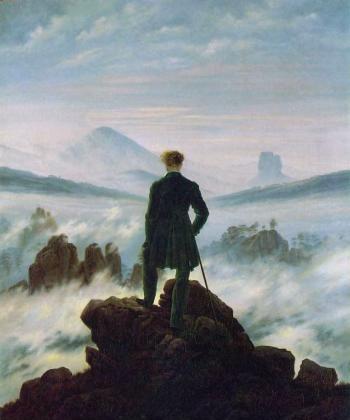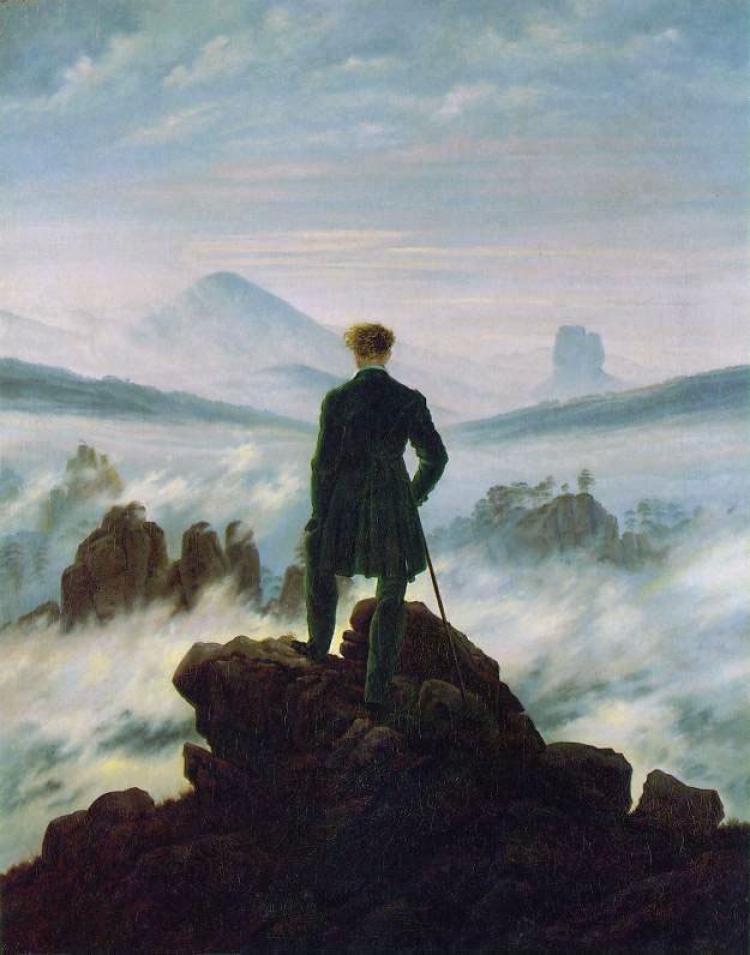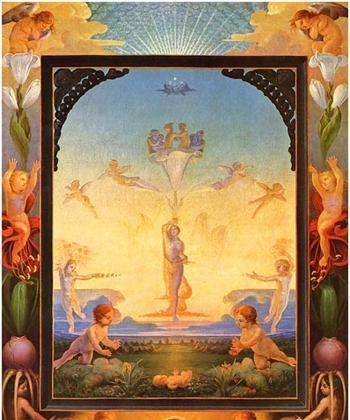A man standing on a formation of rocks, looking upon a sea of fog and clouds - together with other well known landscapes by Caspar David Friedrich the Wanderer above the Sea of Fog marks the peak of German painting in the Romantic era.
Mention the sharp contrast between the foreground and background, the dark silhouette of man and mountain against the misty translucent landscape. You can sense the land underneath, but not clearly see it. Yet whole situation looks so natural and compelling, as Friedrich composed the picture out of different landscape pieces from the Elbe Sandstone Mountains (a mountain range straddling the border between the state of Saxony in southeastern Germany and the Czech Republic).
He used to go out into nature and took many meticulous on site sketches. With a big pile of these drawings he went home and composed the painting itself in his atelier. So some of the mountain tops appearing in the mist here could be identified, but they´re actually situated in different places of the Elbe Sandstone Mountains. So the highly credible view he presents to us doesn´t exist in reality.
Small mankind, big universe
The landscape depicts the soul of a man and carries multiple messages.
Friedrich´s pictures, as they focus on nature rather than people get timeless and transcendental, as inside and outside world seem to be unified in them. This was a great achievement of the romantic era and contemplative Caspar David Friedrich stood out as the master of this kind of art.
Funny, that he made his way though he is said not having been very fond or talented in painting people. He solved this problem with showing them from the back or the side. But there is also this deeper aspect, that nature and universe were the more important topic to him anyway, so he concentrated on talking to the viewer through lanscapes.
People are part of the nature and the same time separated from it, bringing them into the pictures, Friedrich creates another level of awareness. Here the anonymous wanderer makes the picture talk, as he is standing in the very middle of it and turning the back towards the viewer.
The whole painting is about him (but who is he?) and in the same moment the overwhelmingly beautiful landscape part is outside of him. You are invited to identify with him. He could be absolutely anybody, yet we know from other paintings that Friedrich must have looked like that, so he is kind of bringing himself and his view into it, while the dark clothing supports him staying anonymous.
The painting unfolds an overwhelming presence by its size of 37.3 in × 29.4 in and because it was done with such great diligence it is opening a astonishing window into another realm.
You feel to fall or to rise into it, however you let your look eyes wander around in it and can virtually breath the air and cool wind.
The subtle wide color range
The sky looks endless, though it is veiled with scattered, sometimes rugged clouds.
Painting the clouds of mutiple layers using paint from pastose and opaque quality up to transparent layers of translucent varnishes enabled Friedrich to get this great luminance and natural light effects.
When you stand in front of the real painting you´ll sense how amazingly subtle the color changes are and the cloud and sky part looks even shimmery, as he mixed many different pigments into it.
The first impression of blueish white and grey tones as dominant colors follows a perception of rose and violet and even yellow that seems to be present as an almost invisible veil in the whole painting.
The violet significantly deepens the mysterious mood of the whole thing and in terms of coloring technique is proved, that a painter will only achieve an multidimensional and meaningful image in weaving together multiple layers and colors.
This carefulness in coloring and lighting, together with the long term composition work,
give Friedrich´s paintings the depth we love about them. He obviously has been meditating over the pictures for long, sometimes the creation process stretched over several years, what for financial reasons didn´t make life easy for him. However, he went through a process of getting always deeper into his landscapes and closer to the message.
Concentration through composition
The composition comes to you very naturally, yet there is mathematical logic behind.
The rock in the foreground forms a triangle with the wanderer on its top, that´s why Friedrich gets such a strong concentration on the person.
The wanderer stands leaning on a stick, this plus the silhouette of his coat that opens towards the ground helps to connect him to the rock. As he is almost as dark as the ground he stands on, he becomes visually the extension of it. Some have interpreted this rock as a symbol for the believe in god or a higher power, what makes a lot of sense:
Next to the wanderer it looks like going down very deep and the weather also seems to be pretty stormy. An uncomfortable and dangerous place for a human being. In reality one would rest there just for a moment - but he looks as steadfast, like he could stand up there calmly and watch forever.
Nature resonates visibly in the heart
There are two distant mountain silhouettes coming from left and right, that are running as straight lines toward the wanderers upper part of the body and further draw the attention on him. These lines together with many other invisible extensions of compositional lines such as the walking stick meet in the middle of the figure, where his heart is. So Friedrich centers the lines of the outside landscape in the heart of the person, which makes visible the inversion of the inside and outside realm, that was the main idea of the romantic artists.
While watching the outside, man can perceive the greatness and majesty of nature and creation in his heart. His mind may stretch into the heaven above, yet he is still bound to the rock where he is standing on. That way he becomes a symbol for man in universe. He is bound to earth, separated by himself and can´t see the full and true appearance of the surrounding world, as it is covered by fog. He is also confronting adversities and danger such as the steep acclivity and the storm. But when he is peaceful in his heart, he is able to connect to the creation while watching it.
If he quietly and carefully watches out, he will sense the presence of the divine in everything. This is what Caspar David Friedrich did when watching carefully the outside world and depicting it meticulously. The humbleness and dedication he worked with gave him the power to convey a big message with simplest means. Thus he created realms of nature and thought that appear so real and right to us.






